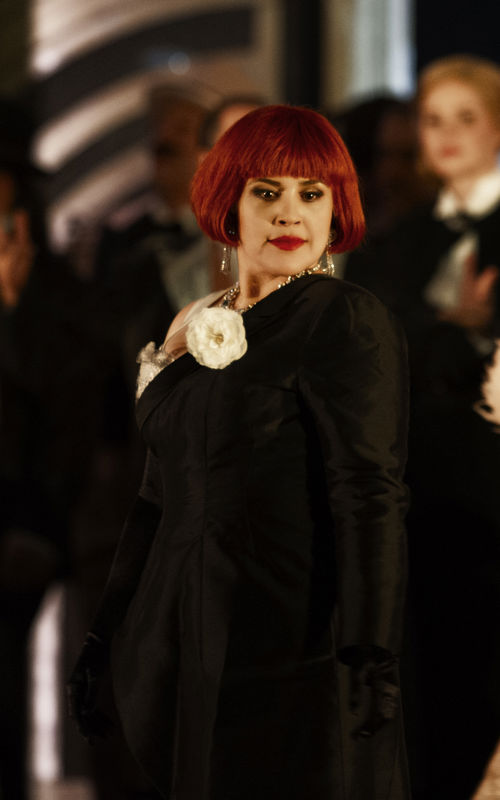A revolutionary woman
 Violetta (Yaritza Véliz) er festens vertinne / Photo: Erik Berg
Violetta (Yaritza Véliz) er festens vertinne / Photo: Erik Berg
Rodula Gaitanou grew up in La Traviata’s world. Her father was the artistic director of the Greek National Opera in Athens, and from a very young age, she played in the wings and slept along the rows of seats.
“Considering today’s proper upbringing in which children go to bed early and life is adapted to them, it probably sounds insane. But we were at the opera house every night. By the time I was seven, I had seen 30 productions of La Traviata. One of my first opera-related memories was practicing a tuberculosis cough in the mirror. I tried to make it believable and I remember how intensely I wanted to get it right!”
She is describing the first scene in Gaitanou’s production in which Violetta Valéry stands before the audience, dying of tuberculosis. In harmony with the strings, she gasps for air. Yet there was something about Violetta that made the seven-year-old girl believe in a happy ending.
“I remember feeling very close to her. This character has so much love to give and as a seven-year-old, I wished so badly for her not to die, again and again. I hope to spark that same childlike, naive hope in the audience,” she says.
Set between two wars
Gaitanou has set the opera in the Art Deco period, the roaring 20s in Paris. An interwar period filled with fun and escapism, but also with the understanding that life can change faster than we can imagine.
“There is much pain in the 1920s, while pleasure is turned up to maximum volume – they really live in the moment. This is reflected in Violetta’s reality: She does not have long to live. Many of those around her have experienced death, misery and heartbreak, and have lost a great deal. They kick up their heels and celebrate knowing fully well that life should not be taken for granted.”
Gaitanou also taps into the shifting political climate of the 1920s and how this is reflected in the characters performed by the Opera Chorus.
“The chorus is divided into five categories: Diplomats, who have travelled and have histories from all corners of the globe. We also have intellectuals and artists. And then there are the sex workers and bankers, who keep the wheels turning financially. It is an eclectic group of people. But what they all share is a strong feeling that life happens here and now.”
Gaitanou believes that this sense of urgency also underlies Violetta’s greatest dilemma: will she dare to let someone in? Will she experience love as the last thing she does before she dies?
“She has never experienced loving and being loved at the same time – fully and unconditionally. That is the real tragedy: this woman, who has devoted her life to making others feel loved and acknowledged, has never experienced this herself. Where others seize the moment, she seizes love.”
Jesus and Beyoncé
Gaitanou has lived with the work her entire 40 years of life: as a child, as the director for restagings at the Royal Opera House in the 90s, and when she staged her own production for the first time in 2018 during the Opera Holland Park festival in London. Yet the work continues to have something new to say to her.
“Verdi’s musical score is incredibly rich. The music moves with the time, from bel canto to verismo, or from ‘beautiful singing’ to ‘realism’. There is so much psychology in the music that it makes the characters whole people. In this work, Verdi accomplished two things simultaneously: putting music to the dramatic situation and putting music to the way in which the characters respond to the dramatic situation in which they find themselves. This is what opera offers us, these layers of humanity,” says Gaitanou.
Who is Violetta to you this time around?
“She has so much room in her for other people, so much goodness. Her entire lightness of being rubs off on others. Even in the most difficult situations in which she is treated deeply unfairly, she still sees the humanity in others. She chooses to forgive and to understand, even those who have betrayed her. And she dies a glorious death, surrounded by everyone she loves. A female Jesus – yes, you might very well call her that,” says Gaitanou and laughs.
Done with the patriarchy
Violetta is betrayed by two men: the man she loves and his father. When Violetta meets Alfredo, she believes in love for the very first time and they move to the countryside, away from Paris. Alfredo’s father, Giorgio Germont, learns about the relationship and demands that Violetta leave his son, so that the family’s reputation and Alfredo’s sister’s wedding will not be ̊ jeopardised. Violetta protests fiercely at first, but eventually gives in. She returns to Paris and Alfredo follows her to seek vengeance. He throws money at her to show that he has paid for her time. Violetta is humiliated, exposed like a piece of meat in a meat market.
What are your thoughts on the battle of the sexes that is so often read into this work? Violetta is both strong in her community and can destroy the man who is her lover, yet is not free to follow her heart. Is there an ambivalence in her power, in having control, yet also being a victim of her time?
“The patriarchy is very much alive and well in this performance, but I do not consider Violetta a victim. Everything she does – her job and her customers – has been her choice. She runs a business, she is a sex worker on the top of her game. All of her gorgeous dresses are her armour, which she can remove when she experiences love with Alfredo. And when she is betrayed, she chooses a different path than the men around her – she is greater than them.”
Gaitanou laughs and continues,
“To be honest, I’m a bit done with seeing this woman controlled by men! In the 1800s, it was common to interpret Violetta as a sinful woman who is being punished by society and diseases for her choices as a high-class prostitute. In the 1900s, she was first and foremost a victim of the patriarchy. In 2023, we can incorporate all of this and also see Violetta, the person. To me, she is a superstar, queen of the night and Beyoncé! She has tremendous integrity that she lives by until she dies.”
So, as I see it, the opera’s love story can be viewed in two different ways: The one is the archetypical femme fragile who meets her prince – Cinderella being saved from misery. The other interpretation is perhaps more modern and revolves around how Alfredo and Violetta choose love beyond the dopamine chase in Paris. Their love does not need to be wild and intoxicating to be valuable.
“Violetta and Alfredo are together because they meet each other on the same emotional level – and, of course, because of chemistry. This becomes a conflict for Alfredo’s father, who belongs to a generation that is concerned about duty, social roles, and does not have a language to express feelings. Alfredo is to take over their ‘empire’ in Province, not follow his heart. And this ‘saved by the prince’ concept doesn’t hold water because she’s the one who supports them!”
… and Alfredo can’t handle that! So, in that respect, he’s the one who’s fragile?
“He has less experience with relationships and love. She is several steps ahead of him. He is emotional, impulsive and rages against Violetta, taking revenge on her later on when she leaves him. It is at this point that we see that Violetta is not in fact a femme fragile. When Alfredo humiliates her, she responds by telling him how much she loves him. She also teaches Alfredo’s father to be a better person. In doing so, she shows how, even after being dealt the worst hand, she chooses to see the good side in people and in life. She is nothing less than a revolutionary individual.”
 Photo: Adam Olsson
Photo: Adam Olsson